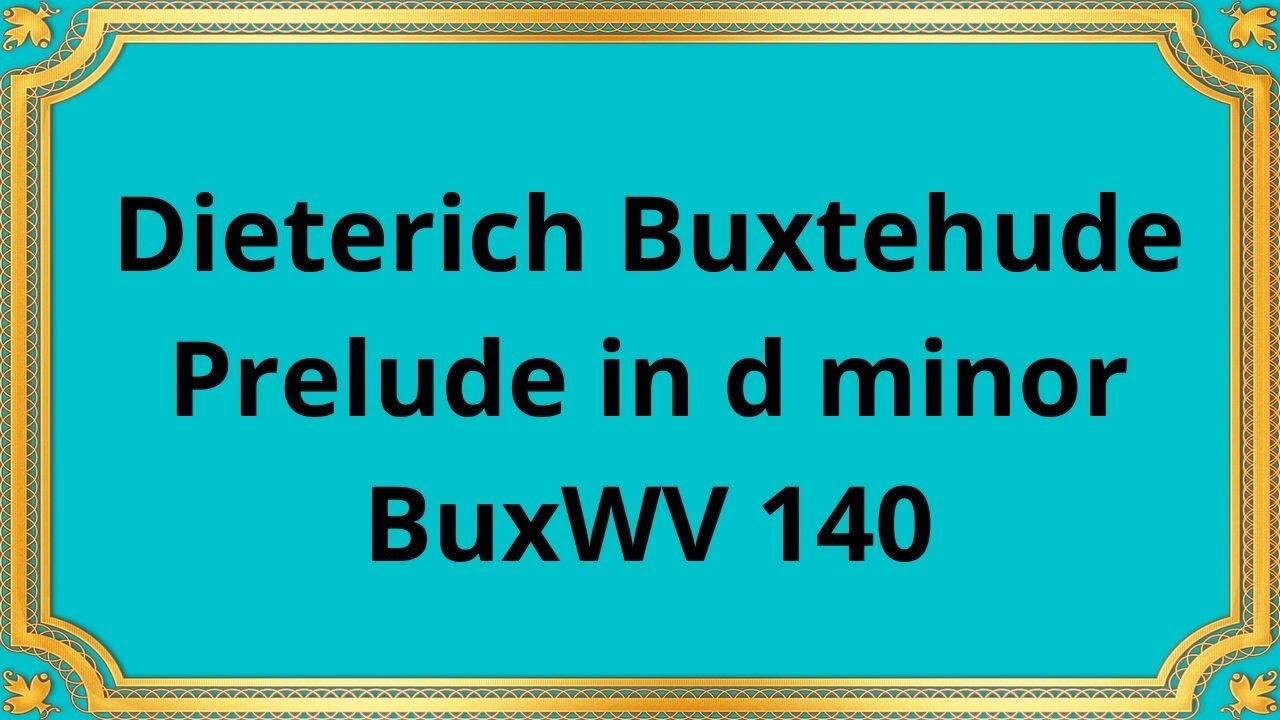Premium Only Content

Dieterich Buxtehude Prelude in d minor BuxWV 140
#DieterichBuxtehude #Prelude #DMinor #BuxWV140 #ClassicalMusic #MusicalComposition
Publication date 1937
Ralph Downes (organ by Snetzler & Walker)
Dieterich Buxtehude's Prelude in D minor BuxWV 140 is a remarkable piece of music that showcases the composer's mastery of the Baroque style. Composed in the 17th century, this prelude exemplifies Buxtehude's ability to create expressive and virtuosic works for the organ.
Dieterich Buxtehude, a Danish-German composer and organist, was one of the most influential figures of the Baroque era. He composed a vast amount of vocal and instrumental music, with his works for the organ being particularly noteworthy. The Prelude in D minor BuxWV 140, often referred to as "Fuga," is one of his most celebrated compositions for the organ.
Introduction:
- The Prelude in D minor begins with a solemn and introspective introduction, setting the mood for the piece.
- Buxtehude establishes a hauntingly beautiful melody, often played in the pedal, which creates a sense of anticipation for what is to come.
Fugue:
- The main section of the prelude is a fugue, characterized by its contrapuntal texture and the interplay of multiple voices.
- Buxtehude's fugue is built on a subject, a short melodic phrase that is introduced by one voice and then imitated by other voices.
- The composer skillfully develops the subject, exploring different key areas and creating intricate and complex harmonic progressions.
- The fugue showcases Buxtehude's mastery of counterpoint and his ability to create a sense of tension and resolution throughout.
Adagio:
- Towards the end of the prelude, Buxtehude introduces an Adagio section, providing a moment of respite and reflection.
- The Adagio is characterized by its slow tempo and expressive melodies, allowing the listener to savor the beauty and emotional depth of the composition.
- Buxtehude's use of rich harmonies and poignant melodic lines creates a sense of introspection and beauty.
Recapitulation and Coda:
- The prelude concludes with a recapitulation of the main themes and a triumphant coda.
- Buxtehude brings the composition to a satisfying and powerful conclusion, leaving a lasting impression on the listener.
Buxtehude's Prelude in D minor BuxWV 140 delivers a range of emotions, evoking a sense of mystery, introspection, and grandeur. The haunting melodies, intricate harmonies, and virtuosic passages create a captivating and emotionally engaging experience. Buxtehude's skillful manipulation of dynamics, phrasing, and melodic development allows for a nuanced and expressive performance, leaving the listener deeply moved and captivated.
Dieterich Buxtehude's Prelude in D minor BuxWV 140 stands as a testament to the composer's exceptional talent and his contributions to the Baroque organ repertoire. Its captivating melodies, intricate counterpoint, and expressive qualities have solidified its place as a significant work in the classical music canon. The prelude's enduring popularity and its inclusion in organ recitals and recordings confirm its lasting impact and the profound influence of Buxtehude's compositional genius.
Conclusion:
Dieterich Buxtehude's Prelude in D minor BuxWV 140 is a masterpiece of the Baroque era, showcasing the composer's exceptional skill and artistry. Through its introspective introduction, intricate fugue, expressive adagio, and powerful conclusion, the prelude takes listeners on a captivating musical journey. Its continued presence in performances and recordings confirms its enduring significance in the realm of classical music, solidifying Buxtehude's reputation as one of the greatest organ composers of his time.
You have the opportunity to support the channel:
https://destream.net/live/RadSiarAl/donate
https://www.buymeacoffee.com/6355radsiaral
-
 20:26
20:26
Classical music_Music Inspiration
1 month agoJohann Sebastian Bach Orchestral Suite No. 2 in B minor, BWV 1066
842 -

Tundra Tactical
5 hours ago $0.07 earned🔫 California Ammo Win, Sig Sauer P320 Controversy, Meme Review & Would You Rather! 🎉🔥
20.6K1 -
 16:24
16:24
Forrest Galante
2 hours ago6 Deadliest Man Eaters to Ever Exist
9.68K3 -
 10:14
10:14
MattMorseTV
7 hours ago $0.34 earnedThe EU is in HOT WATER.
76.4K39 -
 LIVE
LIVE
The Rabble Wrangler
1 day agoPUBG with The Best in the West!
199 watching -
 3:57:19
3:57:19
EvilT4000
5 hours agoSaturday.....🟢For energy and focus click my Dubby link!
17.3K2 -
 LIVE
LIVE
SlingerGames
2 hours agoSpartan Night - Halo and More | Creator for @SELFMADEGGS
49 watching -
 3:57:49
3:57:49
Mally_Mouse
8 hours agoSpicy Saturday!! - 10k CELEBRATION! - Let's Play: Labyrinthine
28.9K1 -
 37:09
37:09
The Mel K Show
9 hours agoMel K & Dr. Kirk Moore | A Doctor’s Oath: Doing What is Right No Matter the Cost | 7-26-25
29.8K11 -
 LIVE
LIVE
Cewpins
3 hours agoCuphead while BLAZED🔥420💨710🍃!MJ
51 watching